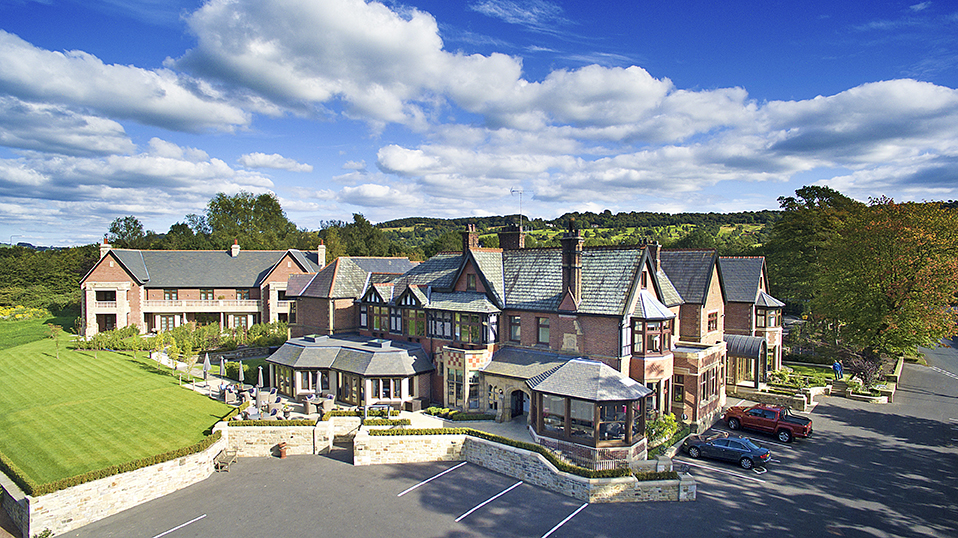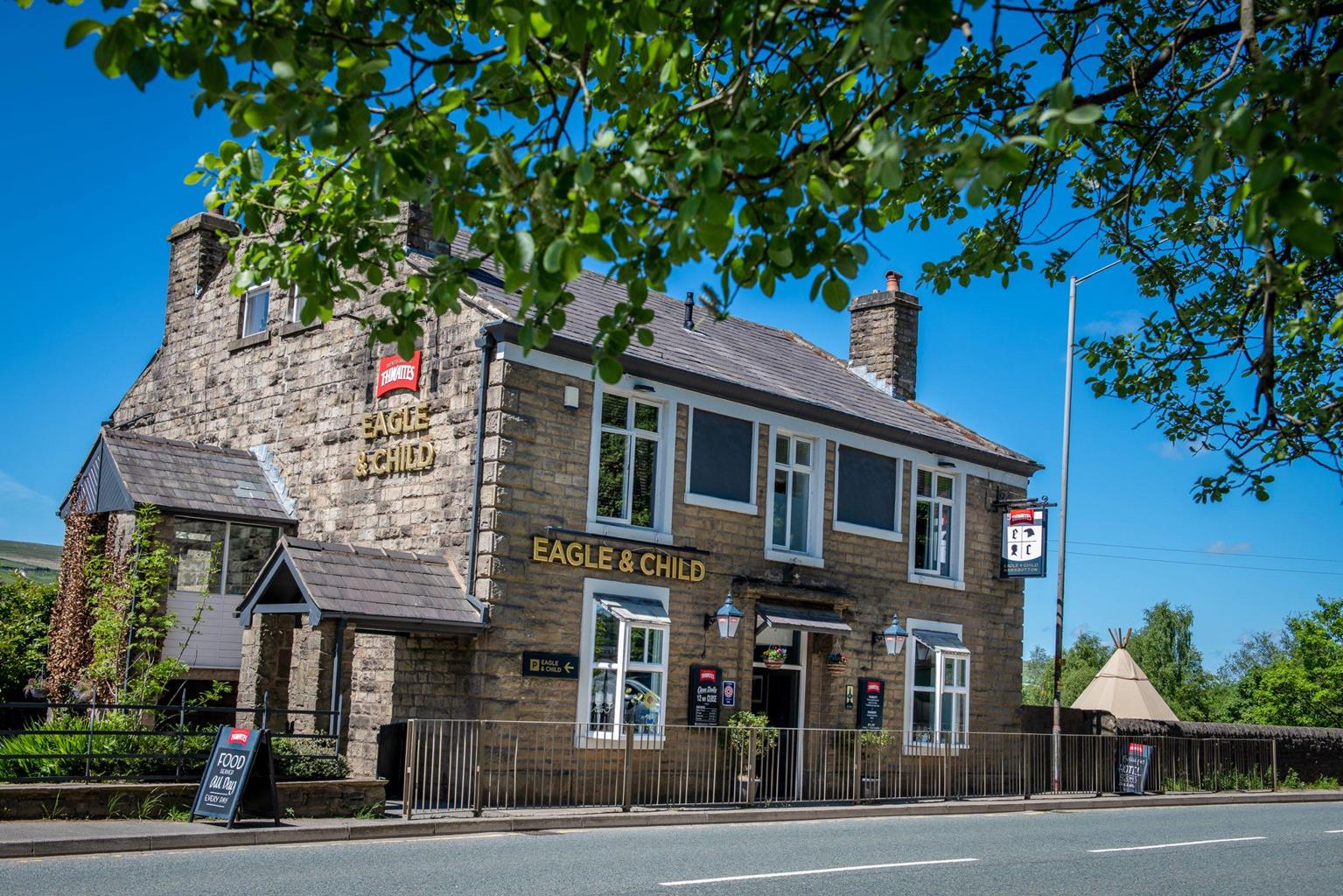Set in the village of Ramsbottom near Bury, Eagle + Child is a friendly inn offering 5 uniquely…
High on Hog Low Pike

Far-reaching views over the Irwell, Darwen and Edgworth valleys
4.5 miles (7.2kms)
About the walk
Today, the upper reaches of the Grane Valley can appear bleak and abandoned, but the area has a long history of human passage and occupation. Mesolithic flints, more than 4,000 years old have been found around Hog Low Pike, which betrays both Old English and Norse influences in its name.
Scattered farmsteads
Until the mid-19th century, the valley was populated with scattered farmsteads and small villages at Calf Hey and Grane Head. The poor soil provided grazing with hay and oats being the main field crops. Meagre incomes from farming were supported by spinning and weaving, with small quarries giving stone for local building and hillside turbaries providing peat for fuel.
Whisky - a lucrative sideline
A lucrative sideline was the distillation of whisky, with sophisticated stills set up in secret basements beneath the cottages and barns. Water was piped in from the streams and flues incorporated into the cottage chimney so that only a single plume of smoke rose from the dwelling. The liquor was reputedly of a high quality, but the Excise officials took a dim view of the enterprise and zealously searched suspected properties. The income lost to the Crown could be considerable and so punishment was accordingly harsh with heavy fines or even imprisonment and hard labour.
Industrial expansion
The industrial expansion of the late 18th and early 19th centuries brought more substantial work to the valley. There were textile mills at Calf Hey and Holden Wood and large-scale quarrying provided stone for the rapidly expanding industrial towns. One of the first quarries opened was at Clough Head, where the upper car park is situated, but by far the largest enterprise was on Musbury Heights across the valley. Extensive ruins remain of offices, workshops and loading platforms and a reconstructed chimney marks the site of a scrubbing mill where the cut stone was polished before being sent out. An extensive tramway moved the stone around the site and an impressive incline took it down to railway sidings in the valley.
Decline of farming
The decline of farming began when the reservoirs at Holden Wood in 1842 and Calf Hey 20 years later, flooded the valley's prime land. The agricultural depression of the 1880s further squeezed local economies before the remaining homesteads were cleared following concerns about water pollution. The quarry continued into the 1930s, but since then the valley has reverted to nature, with scattered relics the only reminders of a once vibrant community.
Walk directions
Follow the ongoing drive down to cross the Calf Hey dam. Leave beyond the spillway over a stile on the left and climb to a lone sycamore above.
Follow a path right for 50yds (46m), then branch left on a narrow path signed to Edgworth. It rises gently across the hillside before passing over a stile into wood. Reaching a crossing path by a post, keep ahead, the way steepening above Hog Low Clough. Stepped towards the top, it breaks from the trees to a junction at the edge of open moor.
Bear right on an intermittently flagged path, heading for Hog Low Pike. Over a couple of stiles, curve across the head of the stream towards a stone wall. There, go right to a stile and continue to the top of the hill.
After reaching the summit, retrace your steps to cross the stile at the bottom, then keep ahead beside the ongoing boundary. Eventually reaching a corner, bend right to stay with the fence for another 300yds (274m) to a junction of fences and gateway.
Swing sharp left on a faint trod across the moor towards the corner of a wall. Through a gap, bear left, soon passing below the ruined farmstead of Causeway End. Continue beyond, cross a broken wall, and then slant downhill to another ruin.
Joining an obvious path, follow it left across the hillside for some 600yds (549m) to the ruin at Rushy Leach. Keep going beyond to the corner of a fence and then bear right on a trod across the moor to a stile at the corner of a wall bounding abandoned quarry workings.
A green path leads away half left. Keep left at a fork, soon reaching a broad, crossing path. Ignoring the path opposite, go right and immediately left on a less distinct path, which leads to the head of a gully, an incline down which stone was lowered to the valley. Bear right, crossing a broken wall to find a stile. A path angles down through heather to a second stile and continues steadily downhill beside a fence.
Meeting a clear path at the bottom, follow it left, shortly winding around the foot of the incline passed earlier. Walk on up the valley, rising above Ogden Reservoir. Cresting a rise by more ruins, the Calf Hey dam comes into view. Carry on through a kissing gate back to the lone sycamore. Drop to the dam and return to the car park.
Additional information
Some indistinct trods, rough moorland and a steep climb and descent, 11 stiles
Rough pasture and moorland, some woodland
Rough grazing, dogs under control
OS Explorer 287 West Pennine Moors
Calf Hey Reservoir car park off B6323 (pay and display). Alternatively use nearby Clough Head Information Centre car park (note that both are locked at 5pm)
At Clough Head car park
WALKING IN SAFETY
Read our tips to look after yourself and the environment when following this walk.
Find out more
Also in the area
About the area
Discover Lancashire
Lancashire was at the centre of the British cotton industry in the 19th century, which lead to the urbanization of great tracts of the area. The cotton boom came and went, but the industrial profile remains. Lancashire’s resorts, Blackpool, Southport and Morecambe Bay, were originally developed to meet the leisure needs of the cotton mill town workers. Blackpool is the biggest and brashest, celebrated for it tower, miles of promenade, and the coloured light ‘illuminations’. Amusements are taken very seriously here, day and night, and visitors can be entertained in a thousand different ways.
The former county town, Lancaster, boasts one of the younger English universities, dating from 1964. Other towns built up to accommodate the mill-workers with back-to-back terraced houses, are Burnley, Blackburn, Rochdale and Accrington. To get out of town, you can head for the Pennines, the ‘backbone of England’, a series of hills stretching from the Peak District National Park to the Scottish borders. To the north of the country is the Forest of Bowland, which despite its name is fairly open country, high up, with great views.
Nearby stays
Restaurants and Pubs
Nearby experiences
Recommended things to do
Why choose Rated Trips?
Your trusted guide to rated places across the UK
The best coverage
Discover more than 15,000 professionally rated places to stay, eat and visit from across the UK and Ireland.
Quality assured
Choose a place to stay safe in the knowledge that it has been expertly assessed by trained assessors.
Plan your next trip
Search by location or the type of place you're visiting to find your next ideal holiday experience.
Travel inspiration
Read our articles, city guides and recommended things to do for inspiration. We're here to help you explore the UK.













